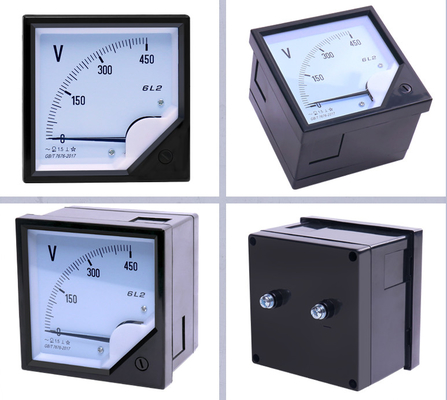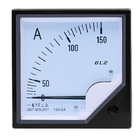-
Differential Pressure Gauge
-
Digital Pressure Gauge
-
Stainless Steel Pressure Gauge
-
Precision Pressure Transmitter
-
Programmable Logic Controller
-
Float Level Switch
-
Pneumatic Valve Positioner
-
Temperature Transmitter Sensor
-
Hart Field Communicator
-
Solenoid Valve
-
Control Valves
-
High Accuracy Flow Meter
-
Submersible Water Pump
-
Pressure Transmitter Manifold
-
Ultrasonic Level Meter
-
Voltage Current Power Meter
Abs 45-65hz Ac Volt Meter High Precision 5A 99T Three Phase

Contact me for free samples and coupons.
Whatsapp:0086 18588475571
Wechat: 0086 18588475571
Skype: sales10@aixton.com
If you have any concern, we provide 24-hour online help.
x| Dielectric Strength | The 50 Hz/ZKV Lasts 1 Min | Damping Time | <4s |
|---|---|---|---|
| The Pointer Deflection Angle | 90° | Inch Specifications | 80×80/120×120 |
| Frequency Range | 45-65Hz | Temperature | -10-45℃ |
| Highlight | 65hz Ac Volt Meter,Ac Volt Meter High Precision 5A,analog panel voltmeter 5A 99T |
||
MC 612 multi-function digital display ammeter pointer single-phase ac 4216 digital high precision measurement of 99 t
Introduction
Ammeter refers to a meter used to measure current in AC and DC circuits. In the circuit diagram, the symbol of the ammeter is "circle A". The current value takes "A" or "A" as the standard unit.
The ammeter is made according to the force of the magnetic field on the energized conductor in the magnetic field. There is a permanent magnet inside the ammeter, which generates a magnetic field between the poles. There is a coil in the magnetic field. There is a hairspring spring at each end of the coil. The springs are connected to a terminal of the ammeter. The spring and the coil are connected by a shaft, and the shaft is opposite. At the front end of the ammeter, there is a pointer. When there is current passing, the current passes through the magnetic field along the spring and the rotating shaft, and the current cuts the magnetic induction line. Therefore, under the action of the magnetic field force, the coil deflects and drives the rotating shaft and pointer to deflect. Since the magnitude of the magnetic field force increases with the increase of the current, the magnitude of the current can be observed by the degree of deflection of the pointer. This is called a magnetoelectric ammeter, which is what we usually use in the laboratory. In the junior high school period, the range of the ammeter used is generally 0~0.6A and 0~3A
Specification
| Accurate level | 0.5 |
| The instrument type | Programmable instruments, digital display type. |
| Input voltage range | AC 0-100V 0-660V |
| Voltage circuit, power consumption | <2VA |
| Current input range | AC1A 5A |
| The power consumption of the current loop | <1VA |
| Frequency range | 45-65Hz |
| The temperature | -10-45℃ |
![]()
![]()
![]()
![]()
![]()
The principle
The ammeter is made according to the force of the magnetic field on the energized conductor in the magnetic field. There is a permanent magnet inside the ammeter, which generates a magnetic field between the poles. There is a coil in the magnetic field. There is a hairspring spring at each end of the coil. The springs are connected to a terminal of the ammeter. The spring and the coil are connected by a shaft, and the shaft is opposite. At the front end of the ammeter, there is a pointer. The pointer is deflected. Since the magnitude of the magnetic field force increases with the increase of the current, the magnitude of the current can be observed by the degree of deflection of the pointer. This is called a magnetoelectric ammeter, which is what we usually use in the laboratory.
Generally, currents of the order of microamps or milliamps can be directly measured. To measure larger currents, the ammeter should have parallel resistors (also called shunts). Mainly use the measuring mechanism of the magnetoelectric meter. When the resistance value of the shunt makes the full-scale current pass, the ammeter is fully deflected, that is, the ammeter indication reaches the maximum. For a few amperes of current, a dedicated shunt can be set in the ammeter. For currents above a few amperes, an external shunt is used. The resistance value of the high-current shunt is very small. In order to avoid errors caused by the addition of lead resistance and contact resistance to the shunt, the shunt should be made into a four-terminal form, that is, there are two current terminals and two voltage terminals. For example, when using an external shunt and millivoltmeter to measure a large current of 200A, if the standardized range of the millivoltmeter used is 45mV (or 75mV), then the resistance value of the shunt is 0.045/200=0.000225Ω (or 0.075/200=0.000375Ω). If a ring (or step) shunt is used, a multi-range ammeter can be made.
![]()
![]()
![]()
Precautions
⒈ Correct wiring.
When measuring current, the ammeter should be connected in series with the circuit under test; when measuring voltage, the voltmeter should be connected in parallel with the circuit under test. When measuring DC current and voltage, you must pay attention to the polarity of the meter, and make the polarity of the meter consistent with the polarity being measured.
⒉ Measurement of high voltage and high current.
When measuring high voltage or large current, a voltage transformer or current transformer must be used. The range of the voltmeter and ammeter should be consistent with the secondary rated value of the transformer. Generally, the voltage is 100V and the current is 5A.
⒊ The expansion of measuring range.
When the measurement in the circuit exceeds the range of the meter, an external shunt or voltage divider can be used, but it should be noted that its accuracy level should be consistent with the accuracy level of the meter.
⒋In addition, it should also be noted that the use environment of the meter must meet the requirements and be far away from the external magnetic field.
Digital display ammeter
The display ammeter is divided into single-phase digital display ammeter and three-phase digital display ammeter. The meter has functions such as transmission, LED (or LCD) display and digital interface. Through the AC sampling of various parameters in the power grid, the measurement results are displayed in digital form. . The data is processed by the CPU. The three-phase (or single-phase) current, voltage, power, power factor, frequency and other electrical parameters are directly displayed by LED (or liquid crystal), and the corresponding analog power of 0~5V, 0-20mA or 4-20mA is output at the same time. RTU connection of the moving device; with RS-232 or 485 interface
![]()
Rules of Use
Ammeter
① The ammeter should be connected in series with the electrical appliance in the circuit (cannot be connected to the two ends of the battery, otherwise the ammeter will be burnt out.);
② The current should enter from the "+" terminal and exit from the "-" terminal (otherwise the pointer is reversed and it is easy to bend the needle.);
③ The measured current should not exceed the range of the ammeter (you can use the method of trial touch to see if it exceeds the range.);
④ It is absolutely not allowed to connect the ammeter to the two poles of the power supply without using electrical appliances (the internal resistance of the ammeter is very small, equivalent to a wire. If the ammeter is connected to the two poles of the power supply, the pointer will be skewed in the light, and the pointer will be burned in the heavy. Ammeter, power supply, wire.).
Note: Burn the meter (ammeter) first, then destroy the source (power supply)










